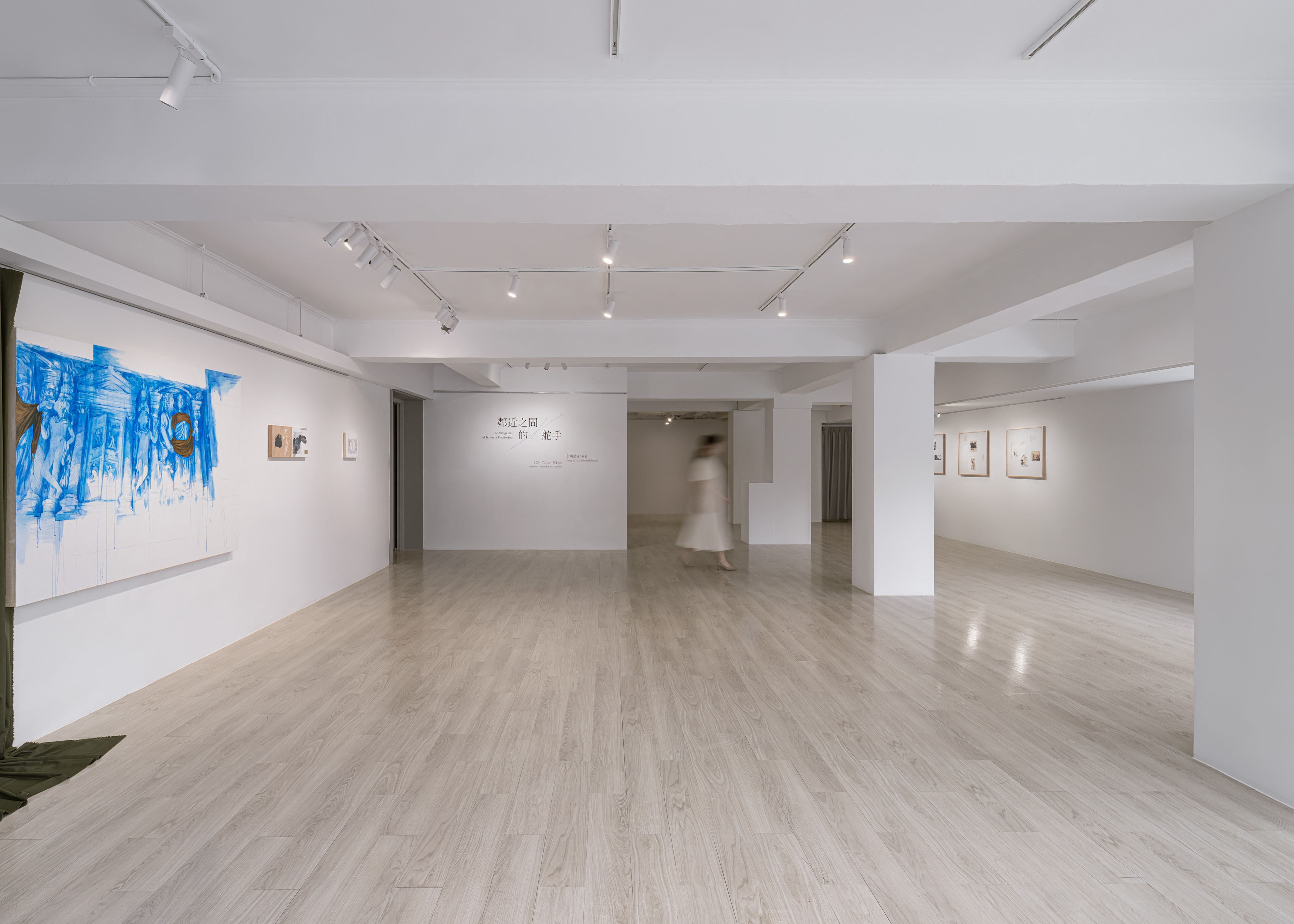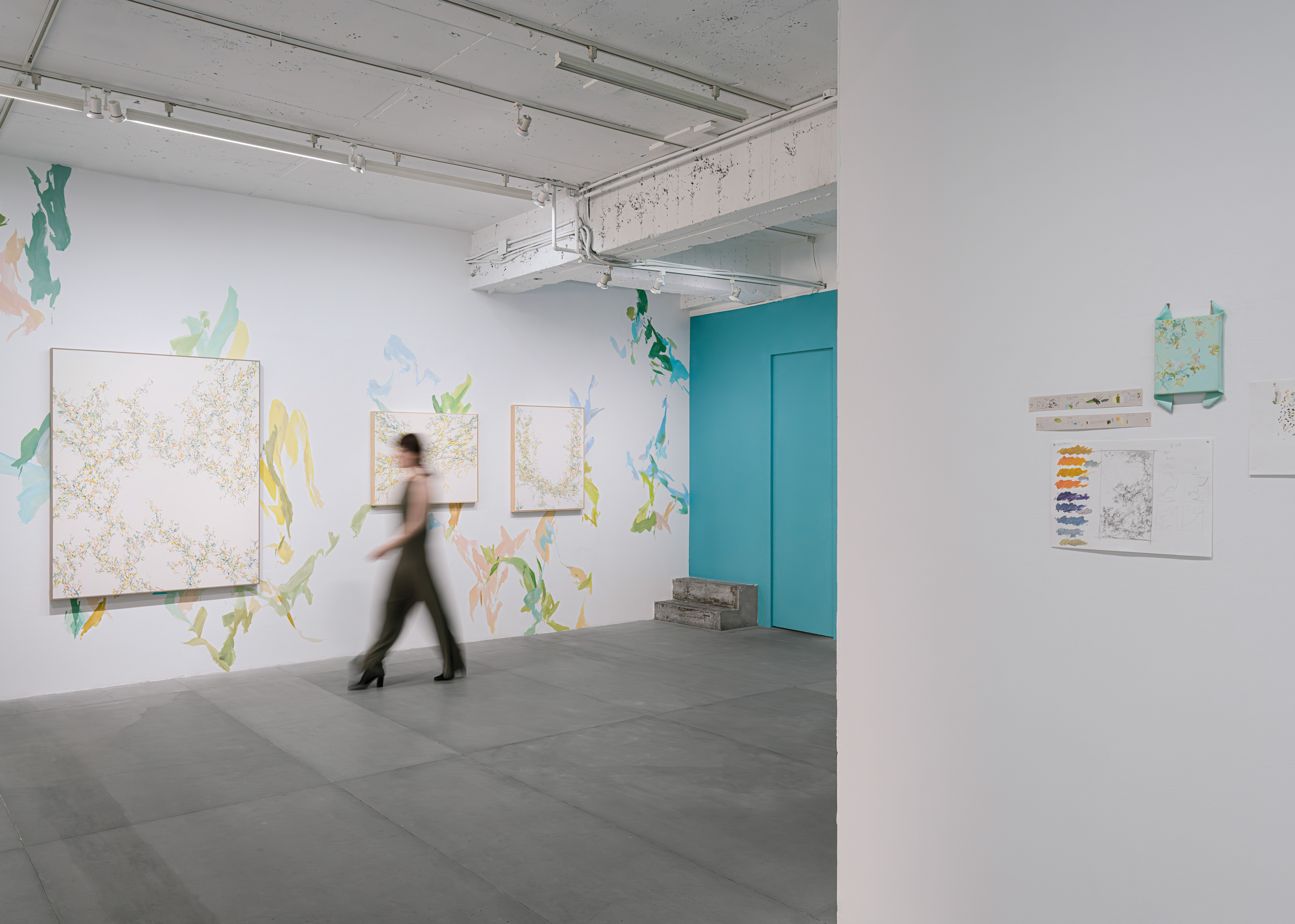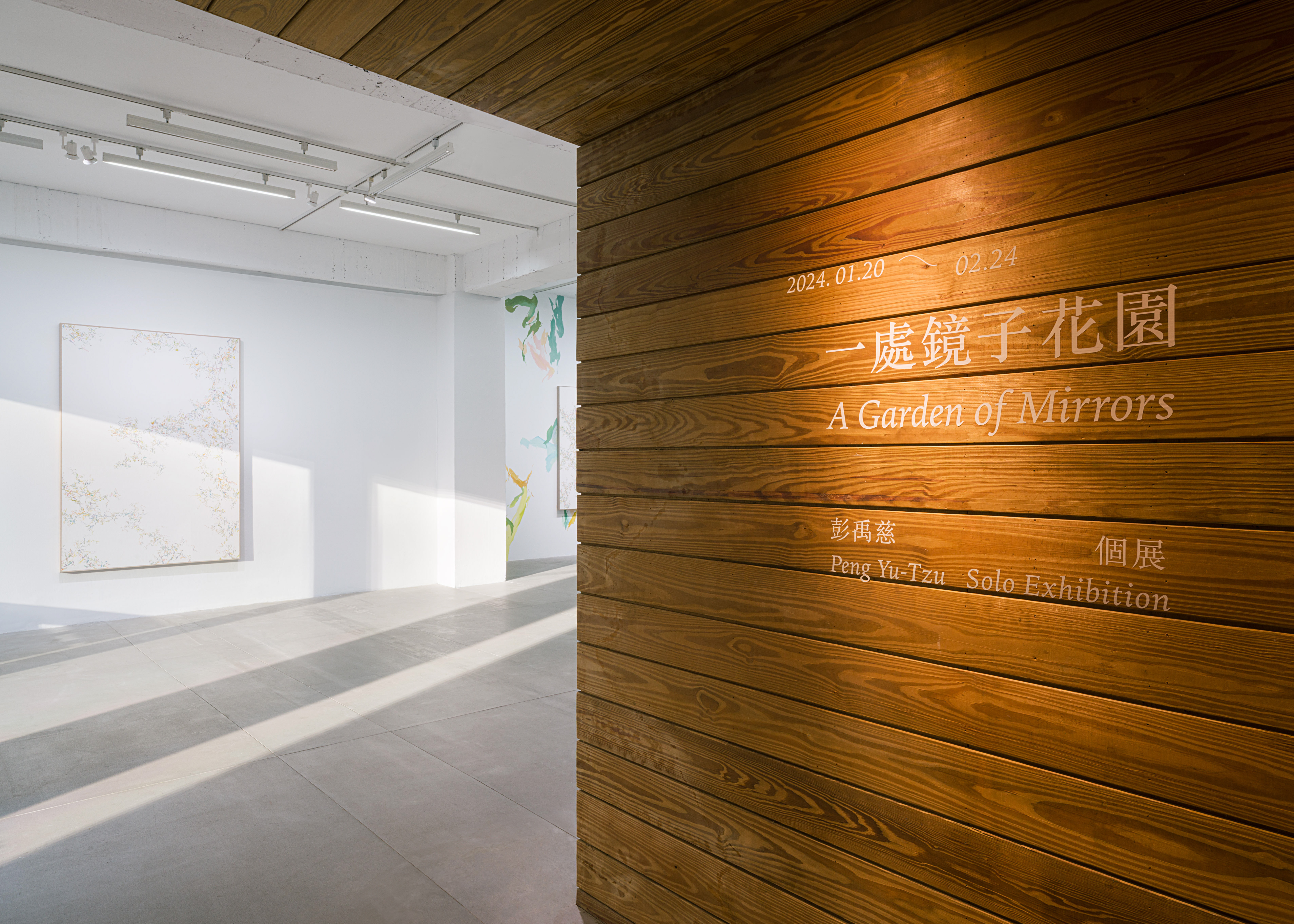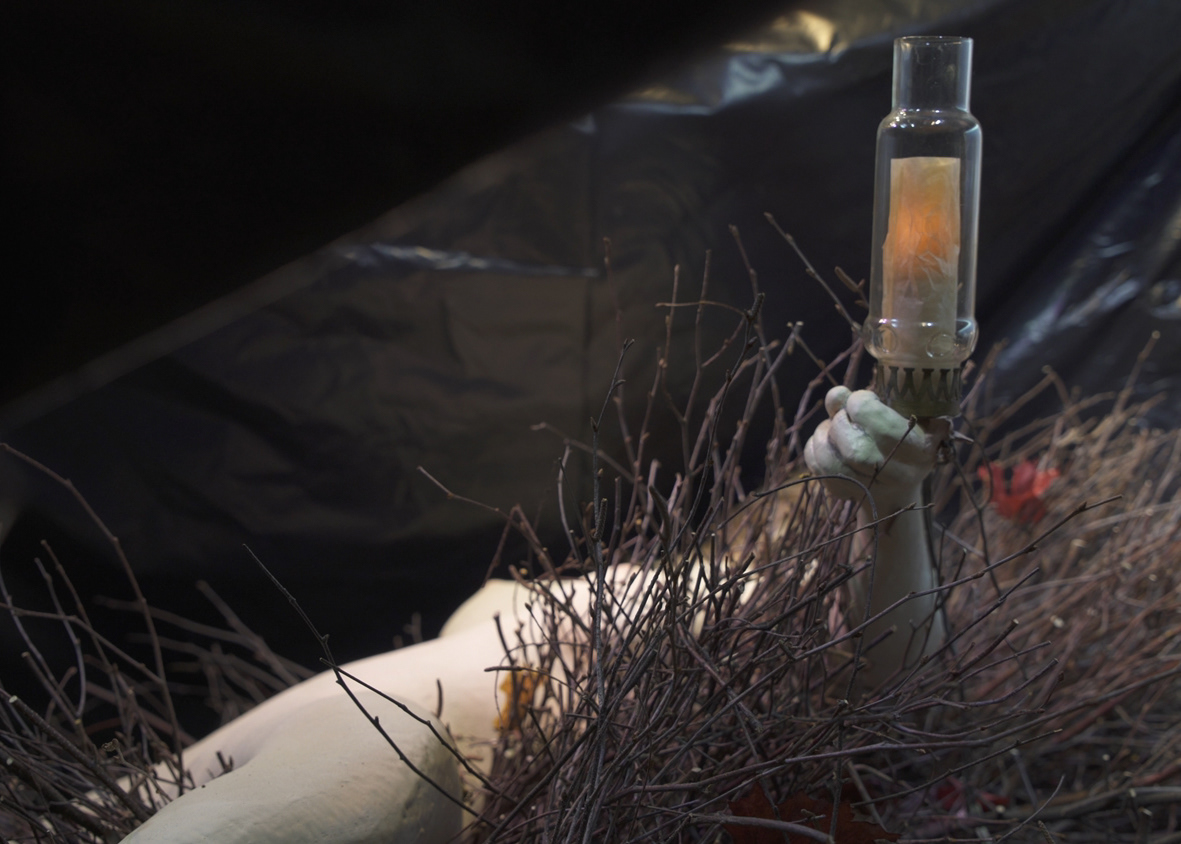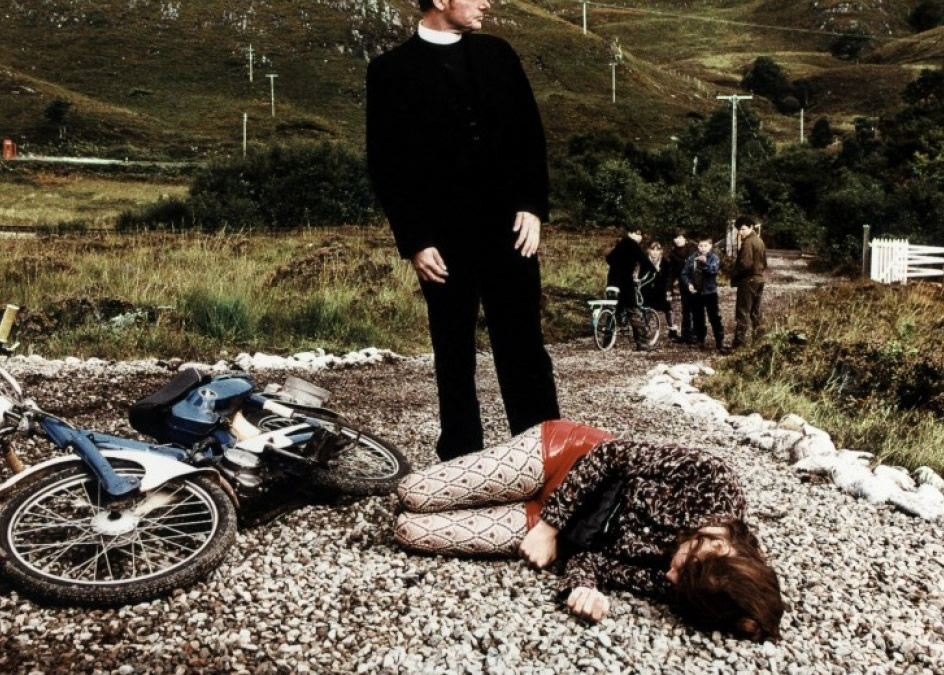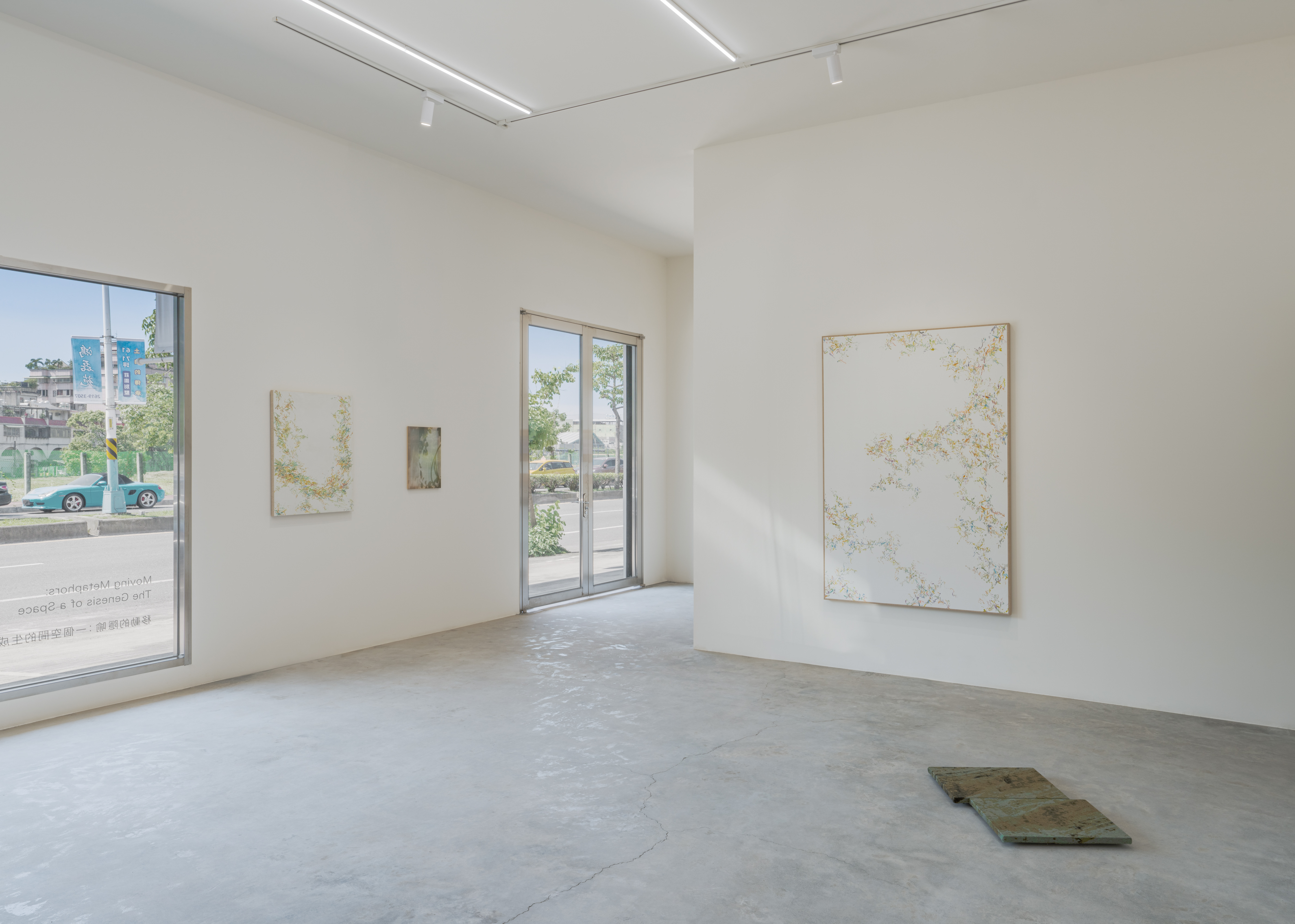縫隙間的海枯石爛
文/陳松志(藝術家、國立彰化師範大學美術系兼任助理教授)
「爛石與枯海」取其文學敘事中「海枯石爛」一詞之於永恆、觸不可及的雙關喻意,透過字詞的反置倒述,作為外部現象與實質精神在直觀(intuition)意義上岐見的闡釋與思考進行題引。恆久以來藝術作為生活文化的顯形表徵,自十九世紀初以降,藝術家開始以浪漫主義(Romanticism)一詞來描繪自身的渴求,然而浪漫主義的字根始源於中世紀,是有關於傳說、奇幻與暴力的傳奇敘事詩(romance)。法國詩人波特萊爾(Charles Pierre Baudelaire)曾提到:「美不應該受到束縛,善並不等於美,美同樣存在於惡與醜之中。藝術之美是窮盡所有能力所表達出來的親密、靈性、色彩和渴求無限。」藝術家如是在可見的現實中為生命留下記錄,亦在藝術的實踐中進行個人理想的精神流放。爛石與枯海彷彿是末世絕境中的一處涼荒,也如是寓示著當下我們所身處的無常世界。想像在這般毀滅的景致中,仍存續著藝術家們不曾被抹去的創造行跡以及浪漫情懷,在有形與無形的世界(視界)之中勾勒出個人定見的輪廓。
在這個命題下,暗示著人與物質世界一段共生、干預的歷程並共時見證毀滅的更新週期。三位藝術家歐靜雲、彭禹慈、陳俊宇在實體上、心理上是以個人的創作思路,觸引出數媒世界帶給身體的幻失與意識騷擾,以及後全球化時代中人性面對時空、環境、歷史的審慎題解。物我游離、生存在動盪的時空中,更加劇了彼此生滅的進程,也激起人性更多超越本能的理想。他們的主題共通強調了通過探索視覺與心理運動的柔性張力,在藝術中優雅地處理人理政治中叛逃的身體圖示。藝術家穿梭在古典與當代的邊界中,在可現的視覺中予以媒材實驗、形式重組以及概念變革,創造出饒富新意的作品,藉此找出自我的表達路線,並異質同聲地實踐在歸返人文精神的道路上。
歐靜雲的創作主題多所觸及集體意識在歷史情結與神話寓言之間的感性糾結。作品中透過自然環境、人造生活以及事件現場矯飾地構築出一式開放的敘事圖譜。他以不同的物種化身投射出生物本能的驅力,在真假幻變的現場間活躍棲身、行動漫遊在不同地帶的環境邊界、跨越了不同的意識立場,在不斷更迭的非常現場突顯慾望與理性的矛盾。藝術家以繪畫視窗造就滿是激情的感官邀請,預留了幾式未完待續的空白間隙,在色料與造型的殘跡中將底層現實不斷地從瑰麗的夢幻中翻攪而出,反覆拆解了強勢、單向的視點(立場),讓幻變的主體、空間在形與意的裂隙中獲得精神的逃逸。
彭禹慈將繪畫作為一處視覺空間與精神思維的媒合地帶,作品專注於創作過程中的精神心理探索,以及對與現實的反向進行造型蒐集。她的製作並不涉及繪畫實際景物,憑藉著想像力和記憶來編織腦海中浮現的形影。她通過繪畫試圖使沒有形狀的光線成形,藉由抽象筆蹟襯托隱現的物理空間。作品之中採以碎形線條的積層,帶出完形整體與尺度之間豐富的信息想像,並有著幾許幻覺和圖像的暗示力量,在多所留白之處凸顯負向空間的隱性張力,其間混沌的筆觸中架構出潛意識與繪畫語言的滲透融合,也同步暗示了繪畫和觀者之間的雙向關係,並向觀眾拋出了一種貼近身體卻感覺陌生的微妙經驗。
陳俊宇主要創作以現場行為和影像藝術為主。他以個人身體作為與環境社會激撞、遇合的現場,並將身體作為認知權力延伸的有機載具,創造成多項視覺隱喻的行為表演。他在表演中尋求極限,克服了現實面前的絕望和尷尬感。在軟性、緩速的精神與身體耗弱下,表達個人在文化認同、社會機制的現存困境。他的創作有著專注的身體凝視以及對內展現的激情濃縮。在動靜之間自我滿足,積澱和催化出現實生活中你我的共感。藝術家以新鮮的生活感把板式的文化意識、符號系統進行幽默瓦解,將過程轉化成形態,試圖在過往及當代的審思中激起感性身體存續的意義與提問。
在絕處的暗黑中,環境造就、強化了個體直覺探勘的潛能。在這裡,有一具缺失的身體、一處空白的空間、以及一段碎裂的歷史有待我們透過知性將它與之填補。在形影模糊之界,藝術家藉以創作的形式來吐露自我的存在,並傳遞給他者滿是想像的超然境域。這是兌現本我的承諾,也是造就奇蹟未來的懷想。我在這段導言中冀以文字跨越理解的鴻溝,連帶出他們之間可能的敘事,讓彼此不遂成獨白,而是綿延,盼望激起這個時代珍貴的精神連動。
Obliteration Amidst Crevices
Text / Chen Sung-Chih (Artist and Adjunct Assistant Professor, Department of Fine arts, National Changhua University of Education)
Translated by Wang Sheng-Chih
Obliteration, the title of this exhibition, owes its inspiration to the idiom “the seas run dry and the rocks crumble” which subtly implies eternity and unreachability. Reversing the sequence of the idiom, this exhibition starts by explicating and contemplating the intuitively observed differences between external phenomena and internal spirit. Arts have long been an explicit manifestation of human cultures. In the early 19th century, artists began to express their personal desires with the term “romanticism.” The etymological root of the term is “romance,” a medieval literary style revolving around legend, fantasy and violence. French poet Charles Pierre Baudelaire stated that, “Beauty shall neither be confined nor be equated to goodness. Beauty exists simultaneously in wickedness and ugliness. Beauty is the intimacy, spirituality, color, and aspiration towards infinity expressed by every means available to the arts.” Artists not only document their lives in the tangible real world, but also set out on an inner journey across the spiritual universe through their artistic practice. Obliteration conveys an impression of a desolate expanse after doomsday, which also alludes to the impermanent world that we live in. Traces still remain of the artist’s creative practice and romantic passion, outlining their individual viewpoints of the tangible and intangible worlds (horizons) in this apocalyptic vision.
This proposition suggests a symbiotic relationship and mutual intervention between humanity and the material world, while witnessing a new cycle that begins with destruction. Treating their creative thinking as the point of departure, the three artists in this exhibition: Ou Jing-Yun, Peng Yu-Tzu and Chen Jun-Yu meticulously address the questions as to how digital media alters the consciousness and causes us to hallucinate, and how humanity can respond to space, time, the environment, and history in the era of post-globalization. Our co-existence with a myriad of entities drift within a turbulent space and time, accelerating the process of our birth and death, but also galvanizes us to transcend the confines of our pure intuition. A common thread in the three artists’ works is the exploration of the corporeal schemata defecting from politics, adeptly examining the inner tension between visual and psychological dynamics. Encompassing the classical and the contemporary, the artists experiment with media, reconfigure forms, and revolutionize concepts, hence their innovative works, where they evolved their distinctive styles.
In terms of embodying the humanistic spirit, the three artists are equally resolute though differ in their approach; Ou Jing-Yun’s art practice primarily touches upon the emotional perplexities of collective consciousness amidst fables and the complexity of history, referencing a Mannerist style, creating an open-ended narrative atlas comprising of the natural environment, artificial life, and sites of events. By projecting the force of biological instinct through incarnations of different species, that actively dwell among the sites interlaced by the real and the virtual and wandering along the boundaries of different environments, they transcend rigid ideological confines and foregrounds the contradictions between desires and rationality in these ever-changing scenes. The artist captivates viewers with his paintings imbued with passionate sensory delight, with empty spaces left intentionally blank in the composition, seemingly to imply the unfinished state of his works. In other words, he constantly excavates the underlying realities from romantic fantasies amid the remnants of color and shape, repeatedly deconstructing the aggressive, subjective viewpoint (position), and offering the volatile subjects and space a spiritual escape amid the crevices between forms and meanings.
Treating painting as a place where visual space and spiritual awareness converge, Peng Yu-Tzu concentrates on psychological exploration in her creative process and collects imagery that are composed through a reversal of reality. Her art practice depicts not so much real scenes or objects as the figments of her imagination. She attempts to render invisible light visible through painting, and highlight the faintly discernible physical spaces with abstract brushstrokes. In terms of composition, her works feature layered fractal lines that ignites the fertile imagination amidst composition and scale, while a hallucinogenic power lurks in the images. The blanks heighten the implicit tension of the negative space, and the chaotic brushstrokes not only facilitate the fusion and mutual infiltration between the subconscious and her painting vocabulary, but also suggest the bilateral relationships between her paintings and the viewers, allowing us to experience intimacy and unfamiliarity simultaneously.
Chen Jun-Yu’s art practice focuses on site-specific performance and photographic works. By treating his own body as the site of collision and encounter with the environment and society, his physicality becomes the organic vehicle for the extension of his conceptual force, through which the artist produces performance–based works brimming with visual metaphors. In his performance, Chen pushes his limits with the strength born through overcoming desperation and awkwardness in face of the reality. Through the soft, slow consumption of his spirit and body, he expresses the current plight of individuals in terms of cultural identity and social mechanism. His art practice encapsulates an intense gaze at the body and passion for internal reflection. Through the fulfillment of each movement and stillness, catalyzes viewers to find a commonplace resonance in his work. The artist not only uses humor and a refreshing sense of life to deconstruct the stereotypical cultural awareness and symbolic system, but also transforms processes into morphological elements, encouraging the enquiry into the sensitive body’s significance and sustainability from profound reflections on the past and the present.
In an environment of dire predicament, the potential for intuitive exploration is unlocked. In this explorative space, there exists the defective body, spaces left blank, and a fragmented history to be interpreted through intellectual perception. In the blurred boundary between forms and shapes, these artists articulate their existence in the form of artistic creation and immerse viewers in a transcendental realm packed with imagination. They not only fulfill their promises, but also envisage a miraculous future. I expect this introduction to bridge the gap of understanding and weave possible narratives among these artists’ works, preventing them from being mere monologues and forging the precious spirit and zeitgeist of this era.
文/陳松志(藝術家、國立彰化師範大學美術系兼任助理教授)
「爛石與枯海」取其文學敘事中「海枯石爛」一詞之於永恆、觸不可及的雙關喻意,透過字詞的反置倒述,作為外部現象與實質精神在直觀(intuition)意義上岐見的闡釋與思考進行題引。恆久以來藝術作為生活文化的顯形表徵,自十九世紀初以降,藝術家開始以浪漫主義(Romanticism)一詞來描繪自身的渴求,然而浪漫主義的字根始源於中世紀,是有關於傳說、奇幻與暴力的傳奇敘事詩(romance)。法國詩人波特萊爾(Charles Pierre Baudelaire)曾提到:「美不應該受到束縛,善並不等於美,美同樣存在於惡與醜之中。藝術之美是窮盡所有能力所表達出來的親密、靈性、色彩和渴求無限。」藝術家如是在可見的現實中為生命留下記錄,亦在藝術的實踐中進行個人理想的精神流放。爛石與枯海彷彿是末世絕境中的一處涼荒,也如是寓示著當下我們所身處的無常世界。想像在這般毀滅的景致中,仍存續著藝術家們不曾被抹去的創造行跡以及浪漫情懷,在有形與無形的世界(視界)之中勾勒出個人定見的輪廓。
在這個命題下,暗示著人與物質世界一段共生、干預的歷程並共時見證毀滅的更新週期。三位藝術家歐靜雲、彭禹慈、陳俊宇在實體上、心理上是以個人的創作思路,觸引出數媒世界帶給身體的幻失與意識騷擾,以及後全球化時代中人性面對時空、環境、歷史的審慎題解。物我游離、生存在動盪的時空中,更加劇了彼此生滅的進程,也激起人性更多超越本能的理想。他們的主題共通強調了通過探索視覺與心理運動的柔性張力,在藝術中優雅地處理人理政治中叛逃的身體圖示。藝術家穿梭在古典與當代的邊界中,在可現的視覺中予以媒材實驗、形式重組以及概念變革,創造出饒富新意的作品,藉此找出自我的表達路線,並異質同聲地實踐在歸返人文精神的道路上。
歐靜雲的創作主題多所觸及集體意識在歷史情結與神話寓言之間的感性糾結。作品中透過自然環境、人造生活以及事件現場矯飾地構築出一式開放的敘事圖譜。他以不同的物種化身投射出生物本能的驅力,在真假幻變的現場間活躍棲身、行動漫遊在不同地帶的環境邊界、跨越了不同的意識立場,在不斷更迭的非常現場突顯慾望與理性的矛盾。藝術家以繪畫視窗造就滿是激情的感官邀請,預留了幾式未完待續的空白間隙,在色料與造型的殘跡中將底層現實不斷地從瑰麗的夢幻中翻攪而出,反覆拆解了強勢、單向的視點(立場),讓幻變的主體、空間在形與意的裂隙中獲得精神的逃逸。
彭禹慈將繪畫作為一處視覺空間與精神思維的媒合地帶,作品專注於創作過程中的精神心理探索,以及對與現實的反向進行造型蒐集。她的製作並不涉及繪畫實際景物,憑藉著想像力和記憶來編織腦海中浮現的形影。她通過繪畫試圖使沒有形狀的光線成形,藉由抽象筆蹟襯托隱現的物理空間。作品之中採以碎形線條的積層,帶出完形整體與尺度之間豐富的信息想像,並有著幾許幻覺和圖像的暗示力量,在多所留白之處凸顯負向空間的隱性張力,其間混沌的筆觸中架構出潛意識與繪畫語言的滲透融合,也同步暗示了繪畫和觀者之間的雙向關係,並向觀眾拋出了一種貼近身體卻感覺陌生的微妙經驗。
陳俊宇主要創作以現場行為和影像藝術為主。他以個人身體作為與環境社會激撞、遇合的現場,並將身體作為認知權力延伸的有機載具,創造成多項視覺隱喻的行為表演。他在表演中尋求極限,克服了現實面前的絕望和尷尬感。在軟性、緩速的精神與身體耗弱下,表達個人在文化認同、社會機制的現存困境。他的創作有著專注的身體凝視以及對內展現的激情濃縮。在動靜之間自我滿足,積澱和催化出現實生活中你我的共感。藝術家以新鮮的生活感把板式的文化意識、符號系統進行幽默瓦解,將過程轉化成形態,試圖在過往及當代的審思中激起感性身體存續的意義與提問。
在絕處的暗黑中,環境造就、強化了個體直覺探勘的潛能。在這裡,有一具缺失的身體、一處空白的空間、以及一段碎裂的歷史有待我們透過知性將它與之填補。在形影模糊之界,藝術家藉以創作的形式來吐露自我的存在,並傳遞給他者滿是想像的超然境域。這是兌現本我的承諾,也是造就奇蹟未來的懷想。我在這段導言中冀以文字跨越理解的鴻溝,連帶出他們之間可能的敘事,讓彼此不遂成獨白,而是綿延,盼望激起這個時代珍貴的精神連動。
Obliteration Amidst Crevices
Text / Chen Sung-Chih (Artist and Adjunct Assistant Professor, Department of Fine arts, National Changhua University of Education)
Translated by Wang Sheng-Chih
Obliteration, the title of this exhibition, owes its inspiration to the idiom “the seas run dry and the rocks crumble” which subtly implies eternity and unreachability. Reversing the sequence of the idiom, this exhibition starts by explicating and contemplating the intuitively observed differences between external phenomena and internal spirit. Arts have long been an explicit manifestation of human cultures. In the early 19th century, artists began to express their personal desires with the term “romanticism.” The etymological root of the term is “romance,” a medieval literary style revolving around legend, fantasy and violence. French poet Charles Pierre Baudelaire stated that, “Beauty shall neither be confined nor be equated to goodness. Beauty exists simultaneously in wickedness and ugliness. Beauty is the intimacy, spirituality, color, and aspiration towards infinity expressed by every means available to the arts.” Artists not only document their lives in the tangible real world, but also set out on an inner journey across the spiritual universe through their artistic practice. Obliteration conveys an impression of a desolate expanse after doomsday, which also alludes to the impermanent world that we live in. Traces still remain of the artist’s creative practice and romantic passion, outlining their individual viewpoints of the tangible and intangible worlds (horizons) in this apocalyptic vision.
This proposition suggests a symbiotic relationship and mutual intervention between humanity and the material world, while witnessing a new cycle that begins with destruction. Treating their creative thinking as the point of departure, the three artists in this exhibition: Ou Jing-Yun, Peng Yu-Tzu and Chen Jun-Yu meticulously address the questions as to how digital media alters the consciousness and causes us to hallucinate, and how humanity can respond to space, time, the environment, and history in the era of post-globalization. Our co-existence with a myriad of entities drift within a turbulent space and time, accelerating the process of our birth and death, but also galvanizes us to transcend the confines of our pure intuition. A common thread in the three artists’ works is the exploration of the corporeal schemata defecting from politics, adeptly examining the inner tension between visual and psychological dynamics. Encompassing the classical and the contemporary, the artists experiment with media, reconfigure forms, and revolutionize concepts, hence their innovative works, where they evolved their distinctive styles.
In terms of embodying the humanistic spirit, the three artists are equally resolute though differ in their approach; Ou Jing-Yun’s art practice primarily touches upon the emotional perplexities of collective consciousness amidst fables and the complexity of history, referencing a Mannerist style, creating an open-ended narrative atlas comprising of the natural environment, artificial life, and sites of events. By projecting the force of biological instinct through incarnations of different species, that actively dwell among the sites interlaced by the real and the virtual and wandering along the boundaries of different environments, they transcend rigid ideological confines and foregrounds the contradictions between desires and rationality in these ever-changing scenes. The artist captivates viewers with his paintings imbued with passionate sensory delight, with empty spaces left intentionally blank in the composition, seemingly to imply the unfinished state of his works. In other words, he constantly excavates the underlying realities from romantic fantasies amid the remnants of color and shape, repeatedly deconstructing the aggressive, subjective viewpoint (position), and offering the volatile subjects and space a spiritual escape amid the crevices between forms and meanings.
Treating painting as a place where visual space and spiritual awareness converge, Peng Yu-Tzu concentrates on psychological exploration in her creative process and collects imagery that are composed through a reversal of reality. Her art practice depicts not so much real scenes or objects as the figments of her imagination. She attempts to render invisible light visible through painting, and highlight the faintly discernible physical spaces with abstract brushstrokes. In terms of composition, her works feature layered fractal lines that ignites the fertile imagination amidst composition and scale, while a hallucinogenic power lurks in the images. The blanks heighten the implicit tension of the negative space, and the chaotic brushstrokes not only facilitate the fusion and mutual infiltration between the subconscious and her painting vocabulary, but also suggest the bilateral relationships between her paintings and the viewers, allowing us to experience intimacy and unfamiliarity simultaneously.
Chen Jun-Yu’s art practice focuses on site-specific performance and photographic works. By treating his own body as the site of collision and encounter with the environment and society, his physicality becomes the organic vehicle for the extension of his conceptual force, through which the artist produces performance–based works brimming with visual metaphors. In his performance, Chen pushes his limits with the strength born through overcoming desperation and awkwardness in face of the reality. Through the soft, slow consumption of his spirit and body, he expresses the current plight of individuals in terms of cultural identity and social mechanism. His art practice encapsulates an intense gaze at the body and passion for internal reflection. Through the fulfillment of each movement and stillness, catalyzes viewers to find a commonplace resonance in his work. The artist not only uses humor and a refreshing sense of life to deconstruct the stereotypical cultural awareness and symbolic system, but also transforms processes into morphological elements, encouraging the enquiry into the sensitive body’s significance and sustainability from profound reflections on the past and the present.
In an environment of dire predicament, the potential for intuitive exploration is unlocked. In this explorative space, there exists the defective body, spaces left blank, and a fragmented history to be interpreted through intellectual perception. In the blurred boundary between forms and shapes, these artists articulate their existence in the form of artistic creation and immerse viewers in a transcendental realm packed with imagination. They not only fulfill their promises, but also envisage a miraculous future. I expect this introduction to bridge the gap of understanding and weave possible narratives among these artists’ works, preventing them from being mere monologues and forging the precious spirit and zeitgeist of this era.
